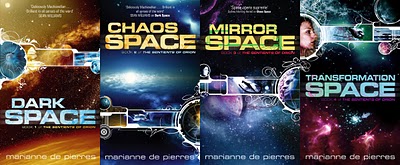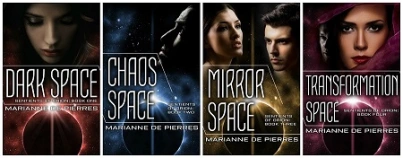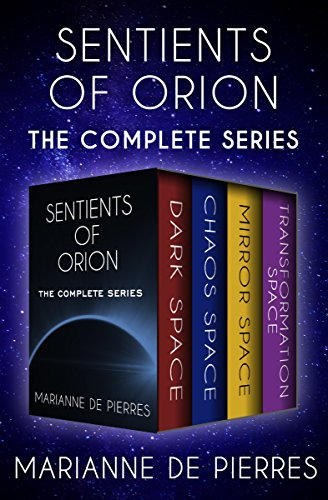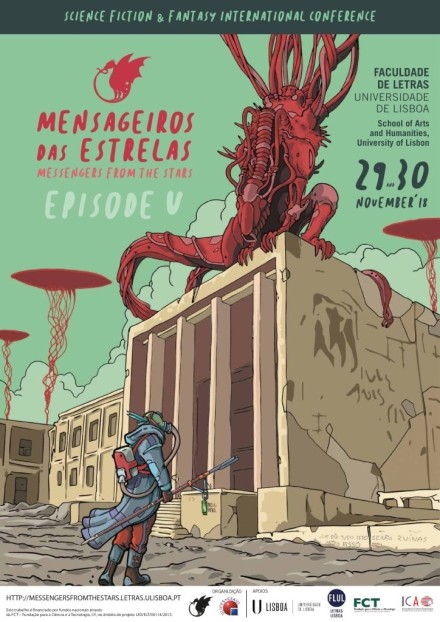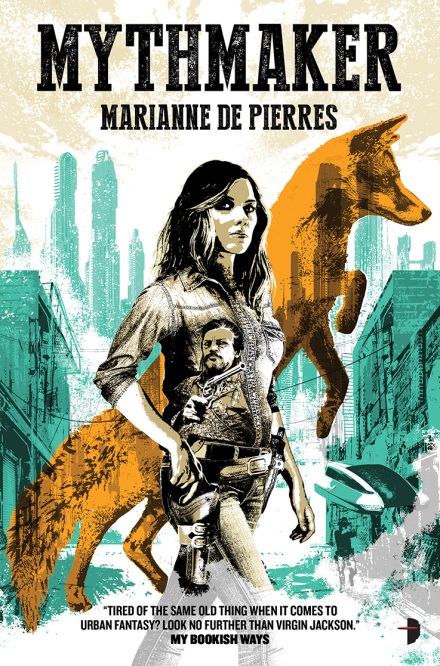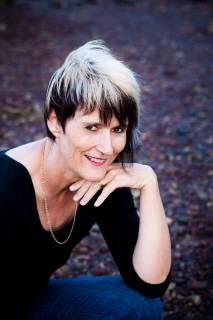Welcome to the Sentients of Orion website, home of the vast, sprawling space opera penned by author Marianne de Pierres. Find out all about this award-winning series.
The Caribbean Gothic Down Under: Caribbean Influences in Marianne de Pierres’ Parrish Plessis Novels
It’s always so humbling to have your work critically explored. This was from a couple of years ago. Though not the Sentients of Orion series, thought I’d share it for those interested in deeper connections to science fiction.
Dr Gerry Turcotte, who is the current President & Principal, St Mark’s College & Corpus Christi College, Vancouver, wrote this research paper, which was published in 2018 in the journal Caietele Echinox. Here is the description from the citation.
The Caribbean Gothic Down Under: Caribbean Influences in Marianne de Pierres’ Parrish Plessis Novels
Author(s): Gerry Turcotte
Subject(s): Studies of Literature
Published by: Fundatia Culturala Echinox
Keywords: Caribbean Literature; Marianne de Pierres’ Parrish Plessis; Gothic; Science Fiction; Indigenous Identity Politics;
Summary/Abstract: This paper investigates the way voodoo, postcolonial theory, Indigenous spirituality and Caribbean culture are brought together to discuss contemporary and future race politics down under in the novel Nylon Angel, Code Noir and Crash Deluxe. Marianne de Pierres’ Parrish Plessis books are edgy, street-smart science fiction novels set in a future Sydney where government has effectively collapsed, media controls its citizenry and gangs vie for control of the streets. In some ways it appears a fairly typical model for SF writing, except that de Pierres has invested great effort in the delineation of racially complex groups. Of these, the encounter between Caribbean (and Voodoo), shamans, and Indigenous Kaidaitcha men, makes for are freshing, but uncomfortable, contemporary negotiation of race politics in Australia.
“Is there a Woman in this Space Opera?”A Gender Analysis of the Aliens of Orion
Delighted to share another scholarly article from Dr Thea Boschoff and Dr Deidre C Byrne that explores the Sentients of Orion world. Below is the publications details and a description from the citation:

“Is there a woman in this space opera?” a gender analysis of the aliens of Orion.
Authors – Dorothea Boshoff, Deirdre C Byrne
Publication date – 2021
Journal – Fafnir–Nordic Journal of Science Fiction and Fantasy Research
Publisher – The Finnish Society for Science Fiction and Fantasy Research
This article provides a textual analysis of The Sentients of Orion, a space-opera series by Australian feminist SF author Marianne de Pierres, with a view to investigating the series’s depiction of aliens as a reflection of contemporary views of human gender. This highlights the question of whether aliens are still used to reflect on the state of human gender roles now that society is moving past the simple black and white of the male/female binary. We undertake a qualitative exploration of selected aliens through the theoretical lenses of Judith Butler’s theory of gender as performative and queer theory. By drawing on these interpretive paradigms, we suggest that de Pierres’s aliens both register and reflect a significant broadening of the gender spectrum.
The Echo of Love
On January 2021, Aiki Flinhart published an anthology described as:
Futures and pasts, Fearless and Frightening.
Relics, Wrecks, and Ruins is a must-read collection for all fans of sci-fi, fantasy, and horror. A celebration of legacy.
* Bizarre remnants of a lost civilisation emerge from the ice.
* The ghosts of a drowned town wait to be awakened.
* A witch with a dragon problem.
* What Elvis will do to protect his fellow artists from annihilation.
* An ancient spaceship carries the last, fragmented memories of Earth.
* Broken souls of the dead are passed on to the new-born.
…These and many more tales showcase the hopes, remnants, and fears of humanity.
In this collection is a story set in the Sentients of Orion world, entitled “The Echo of Love.”
Runnalong the Shelves described it as:
The Echo of Love by Marianne de Pierres – a rather obnoxious human expert is asked by the space station management to interview a strange casket that may contain an alien. A story that mixes understanding of language, love with something eerie building to a memorable finale. A lovely puzzle of of a tale for the reader to solve.
The full table of contents includes:
Washing the Plaid by Juliet Marillier
The Names of the Drowned are These by Angela Slatter
The God Complex by Jan-Andrew Henderson
A Malediction on the Village by Garth Nix
In Opposition to the Foe by Pamela Jeffs
The Echo of Love by Marianne de Pierres
16 Minutes by Jasper Fforde
American Changeling by Mary Robinette Kowal
Pattern on Stone by James S.A. Corey
The Wreck of the Tartarus by Lee Murray
Six-String Demon by Sebastien de Castell
The Shard by Ian Irvine
The Wind and the Rain by Robert Silverberg
Thaw by Mark Lawrence
Morgan of the Fay by Kate Forsyth
Geisha Boy by Kylie Chan
Cosmic Spring by Ken Liu
Dreams of Hercules by Cat Sparks
River of Stars by David Farland
The Mirror in the Mirror by Jack Dann
Relict (noun) A Widow; a thing remaining from the past by Alison Goodman
Heartbreak Hotel by Dirk Flinthart
The Movers of the Stones by Neil Gaiman
Scholarly Analysis of the Sentients of Orion
The Sentients of Orion series has been the subject of scholarly interrogation on several occasions. Click the images to link to the essays and books.

Boshoff, Dorothea, ‘Becoming Alien(ated): A case study examining intimacy and loneliness in selected works by Marianne de Pierres.’ (upcoming 2020)


Sentients of Orion in omnibus version
The Sentients of Orion series is now available in an omnibus version from Open Road Media. This is the absolutely best way to read it, so grab a set and BINGE!
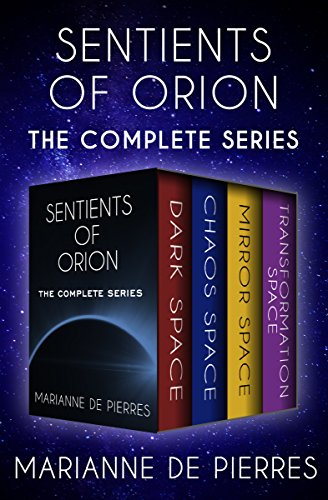
The Aliens of Orion
Some of you may remember that Dr Thea Boshoff wrote her PhD thesis about my Sentients of Orion series. Her thesis is entitled:
Crafting positions: representations of intimacy and gender in The Sentients of Orion.
Well, Thea just contacted me to say that she’ll be presenting a paper called *The Aliens of Orion* at a conference in Lisbon. The main theme of the conference is what it means to be human. Thea’s paper shows how the progression in my depiction of aliens reflects a progression in the nature of humanity.
Here is the poster from the conference. Giant lobsters. What is not to love?
Wish I could be there!
Interview with MARIANNE DE PIERRES
Civilian Reader interview!
 Let’s start with an introduction: Who is Marianne de Pierres?
Let’s start with an introduction: Who is Marianne de Pierres?
I’m an Aussie speculative fiction writer with about 17 published novels. A couple of my series have been released in the US, but mostly they are available in Australia and the Commonwealth countries. My websites tell more about me than I can coherently explain and not bore you to death, so go and check them out: main, Burn Bright and Tara Sharp Series. I tend to write across genres.
Your next novel, Mythmaker, will be published by Angry Robot. It’s the latest in your Peacemaker series: How would you introduce it to a potential new reader, and what can fans of the series expect?
It’s a real genre mashup. Think classic Western pulp fiction with a female protagonist, set in Australia, but paranormal! At heart it’s an old school Western adventure, a conservation novel, and a story about dislocated communities.
View original post 657 more words
Author Interview: Marianne de Pierres
I talk to MYLIFEMYBOOKMYESCAPE
 Today I am interviewing Marianne de Pierres , author of the new urban fantasy/SF Western novel, Mythmaker.
Today I am interviewing Marianne de Pierres , author of the new urban fantasy/SF Western novel, Mythmaker.
◊ ◊ ◊
DJ: Hey Marianne! Thanks for stopping by to do this interview!
Could you start things off by telling readers a little bit about Mythmaker?
Marianne de Pierres: Hi DJ! Great to meet you! MYTHMAKER is the sequel to PEACEMAKER, a story set in a future Australia about a park ranger and a US Marshall who have to work together to keep mythological creatures from overrunning the world. Their relationship is uneasy at best, and the series is action packed. I blend the Western genre with urban fantasy and a little SF.
DJ: Can you briefly tell us a little about your main character? Does she have any cool quirks or habits, or any reason why readers with sympathize with her?
MP: Her name is Virgin Jackson; an unusual…
View original post 725 more words
CliFi, et al. by Marianne de Pierres
On my PEACEMAKER blog tour, I talk to the Skiffy and Fanty show about CliFi – climate fiction.
Marianne de Pierres is the author of the popular PARRISH PLESSIS trilogy and the award-winning SENTIENTS OF ORION and PEACEMAKER series.
The PARRISH PLESSIS series has been translated into many languages and adapted into a role-playing game, while the PEACEMAKER series is being adapted into a novel adventure game. The sequel to PEACEMAKER, MYTHMAKER was just released by Angry Robot Books.
Fictional dystopias born from climate change are increasingly prevalent in fiction. Not that it’s a new concept … JG Ballard wrote The Wind from Nowhere, The Drowned World and The Burning World back in the ’60s, and they weren’t the first CliFi novels by any means. Jules Verne, I believe, wrote one in 1889. Recently though, the sub-genre has gained momentum as particularly seen in the success of Paolo Bacigalupi’s The Windup Girl, and Margaret Atwood’s Oryx and Crake trilogy.
View original post 341 more words
The Echo of Love in Cosmos
 I’m delighted to say that my new Sentients of Orion short story The Echo of Love has been sold to Cosmos Magazine. I’m not sure which edition it will be in, but I’ll share details when I know.
I’m delighted to say that my new Sentients of Orion short story The Echo of Love has been sold to Cosmos Magazine. I’m not sure which edition it will be in, but I’ll share details when I know.
As I mentioned in the previous post, the story was based on a dream. It’s the first time I’ve ever written a story in this way, but the fact that the memory of it stayed with me for several years before I wrote it, suggests there was something important I needed to explore.
It’s a story about the limitations of personal perception and is set on a space station.

